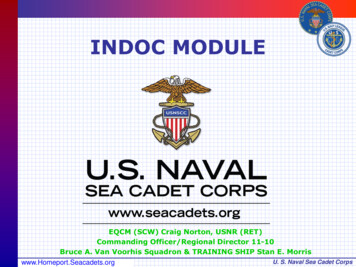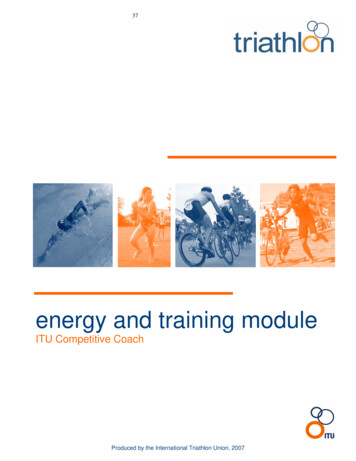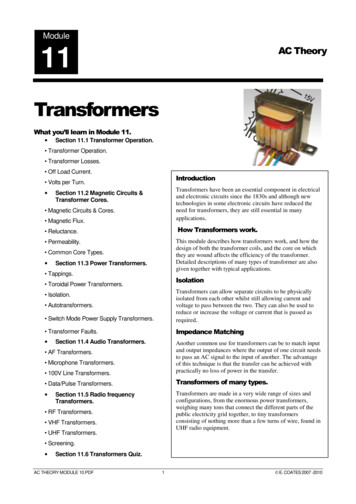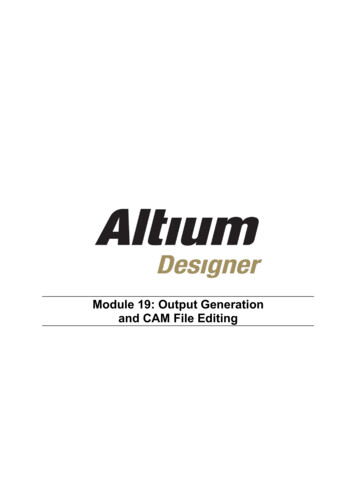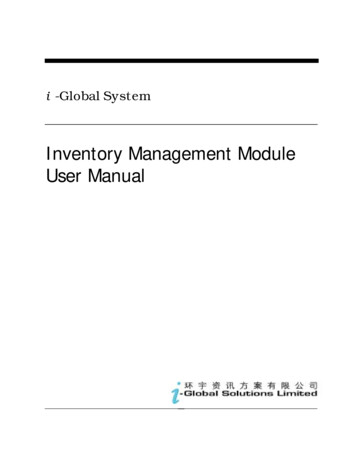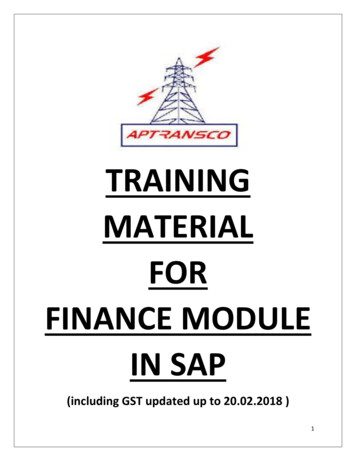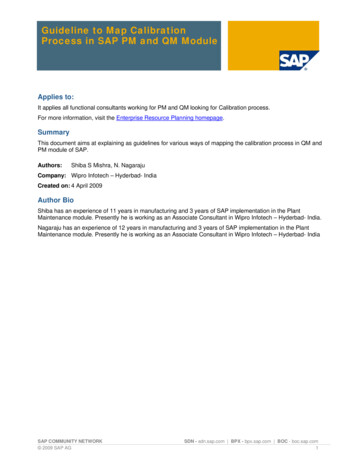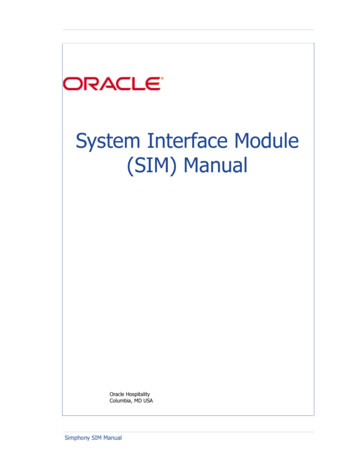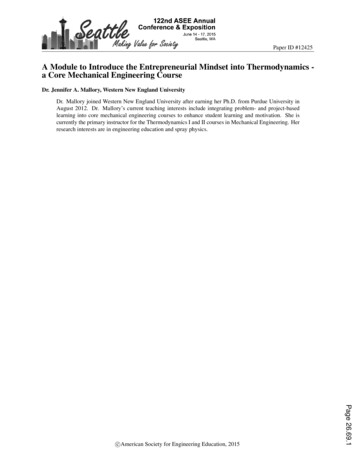
Transcription
Paper ID #12425A Module to Introduce the Entrepreneurial Mindset into Thermodynamics a Core Mechanical Engineering CourseDr. Jennifer A. Mallory, Western New England UniversityDr. Mallory joined Western New England University after earning her Ph.D. from Purdue University inAugust 2012. Dr. Mallory’s current teaching interests include integrating problem- and project-basedlearning into core mechanical engineering courses to enhance student learning and motivation. She iscurrently the primary instructor for the Thermodynamics I and II courses in Mechanical Engineering. Herresearch interests are in engineering education and spray physics.Page 26.69.1c American Society for Engineering Education, 2015
A Module to Introduce the Entrepreneurial Mindset intoThermodynamics - a Core Mechanical Engineering CourseAbstractThe work proposed here consists of an educational module designed for thermodynamics (a coreMechanical Engineering course) that promotes entrepreneurially-minded problem-solving bylinking the application of theory with economic and environmental costs. It was designedspecifically to provide students with a hands-on approach to learning, while giving themexposure to integrating technical design and entrepreneurship. This was accomplished using aniterative design process of an electric-generating power plant that compared performance, cost,and environmental effects as key metrics. Additionally, a socio-political aspect is instilledthrough “governmental regulations” introduced throughout the course of the project. The modulewas implemented twice in Thermodynamics II. After each execution, a preliminary study wasconducted via student surveys to determine if students considered the module a valuable additionto the course. These preliminary findings aimed at not only determining if the module should becontinued in the future, but also at evaluating if the module resulted in: (1) increased studentengagement and interest in thermodynamics, (2) increased learning effectiveness, (3) skillsgained to help students integrate technical solutions with market interest, and (4) additional skillsgained to help students develop the entrepreneurial mindset. Preliminary findings conclude thatstudents perceive this module to be a great tool for not only improving learning effectiveness andengagement, but also for stimulating the entrepreneurial mindset. Future work will evaluate thedeveloped module using quantitative data from bi-weekly progress reports, final projectproposal, final presentation, team evaluation, and student surveys to validate these preliminaryfindings.1. IntroductionPart of the key tenant of engineering education is to provide the skills necessary to develop noveltechnical solutions to problems. Investigations into the most effective pedagogies thataccomplish this have been a focal point among institutions for years. However, if the U.S. is tomaintain its economic leadership position, innovation is the key, and engineering education mustbe adjusted to incorporate innovative thinking while emphasizing the need to maximize customervalue1. This is especially important considering the evolution of a global marketplace.Page 26.69.2Known effective pedagogies, such as active-learning or problem-based learning, have positivelyinfluenced engineering education. However, in “The Engineer of 2020: Visions of Engineeringin the New Century,” the National Academy of Engineering identified that engineering educationis still deficient in meeting the challenges associated with preparing students to succeed in aglobal economy1. In other words, our current education practices lack instruction on how toincorporate the customers’ needs into a technical solution. To accomplish this and ensure theU.S.’s economic competitiveness, known effective pedagogies must be integrated with anentrepreneurial mindset. This mindset will take engineering education beyond providing studentsjust a technical background, but will develop innovative thinkers who consider the value to thecustomer in their solutions.
Although many colleges offer courses focusing on innovation and entrepreneurship, none haveintegrated these topics with thermodynamics, a core Mechanical Engineering course.Thermodynamics is used by engineers in their study and design of a wide variety of energysystems, such as jet engines or power plants. Also, thermodynamics is a course known to beproblematic both in teaching and learning2. The author believes this is due to students’perception of thermodynamics as an abstract topic (i.e. they cannot see energy flow like a fluid,or a structure standing). Thus, students memorize equations and never truly understand whatthose equations mean or how to apply them3.Realizing this student perception, it was hypothesized that by coupling the entrepreneurialmindset with known effective pedagogies, students would gain a better understanding ofthermodynamic concepts, while becoming better engineers. Therefore, a problem-based learningmodule was designed to make students think in terms of what the customer sees as value, and toshape the technical solution to maximize that value. A preliminary study was conducted todetermine if integrating the entrepreneurial mindset into thermodynamics improved students’understanding of the technical content associated with the course and the ability to integratecustomer value into a technical solution. It should be noted that this module is in no wayintended to prepare entrepreneurs. The goal was to prepare entrepreneurially-minded engineers.2. Common Problems in Teaching / Learning ThermodynamicsIt is no secret that students have had difficulty with learning thermodynamics for decades. As aresult, many researchers have written on the issue and proposed solutions to improve studentlearning. Normah Mulop et al. reviewed techniques by various researchers from the past fewdecades that were aimed at enhancing the teaching and learning of thermodynamics. Manyresearchers found that students faced difficulties in understanding basic concepts, such asentropy or the first law, and their use for concrete applications4.In addition to misconceptions regarding basic concepts, students also have trouble in actuallysolving thermodynamic problems. Often times they do not understand the problem statement oreven know where to begin. These difficulties associated with problem-solving can result infurther complications as problems become more complex. This especially becomes true whenstudents attempt to solve common thermodynamic problems, such as a power plant, whichinvolves the integration of numerous devices and processes. Students have a difficult timemapping the abstract, theoretical thermodynamic principles to the complex power plantoperation, preventing them from being able to complete an analysis2, 3. One researcher found thateven visiting a real power plant did not help the students’ understanding. This was due to thehuge size of the plant, which made it hard to conceptualize how the different cycles andcomponents work together4. Unfortunately as a result, students are unable to applythermodynamic concepts to real situations, hating the course and perceiving it to be impossiblydifficult.Page 26.69.3Due to these difficulties, various methods for enhancing the teaching and learning inthermodynamics have been tried over the past few decades. It is certain that when traditionalteaching methods are used they are not effective in aiding students in the retention ofthermodynamic knowledge5. However, simply implementing alternative teaching methods into
the classroom, such as active or problem-based learning, does not ensure that student learningwill be enhanced or they will become better engineers. An engineer’s job does not end withunderstanding how to apply theory. The job of an engineer is to provide a technical solution thatmaximizes the customer’s value. These pedagogies lack the instruction for students toaccomplish this, which is where the entrepreneurial mindset comes in.3. What is the Entrepreneurial Mindset?The goal of this course module is to integrate the entrepreneurial mindset into thermodynamics, acore Mechanical Engineering course. So what exactly is the entrepreneurial mindset then?Robert Kern6, the founder of the Kern Family Foundation, explains the entrepreneurial mindsetas, “An entrepreneurial mindset is our whole outlook on life, a curiosity level that leads us tounderstand what is taking place outside of the world we’re living in—because ideas can comefrom anywhere. This curiosity that characterizes the mindset also tells us that life has to becomea continuous learning process, and if people are not willing to commit themselves to acontinuous learning program, either formal or informal, then they will be left behind. Theworld’s changing too fast and it’s a continuous challenge. There’s something new to be learnedevery day. All of this put together wraps itself up to developing an entrepreneurial spirit.”Since this early description of what an entrepreneurial mindset encompasses, key attributescharacteristic of an entrepreneurial engineer have been specifically defined. These attributes andcorresponding skills are outlined in Table 16, 7.These defining characteristics of an entrepreneurially-minded engineer were adopted for thiscourse module because of their wide acceptance and detailed description. Of thesecharacteristics, the following were a focus for this course module: Curiosity, Creating Value,Engineering Thought and Action, Collaboration, Communication, and Character.Page 26.69.4
Table 1: Attributes of an entrepreneurial mindset6, 7AttributeCuriosityConnectionsCreating ValueEngineering Thoughtand ActionCollaboration CommunicationCharacter SkillsDemonstrate curiosity about our changing worldIntegrate information from many sources to gain insightIdentify unexpected opportunities to create extraordinary value forthe customerPersist through and learn from failure to learn what is needed tosucceedApply critical and creative thinking to ambiguous problemsApply system thinking to complex problemsEvaluate technical feasibility and economic driversExamine societal and individual needsEffectively collaborate in a team settingConstruct and effectively communicate engineering solutions ineconomic termsSubstantiate data with factsEffectively manage projectsDiscern and pursue ethical practices4. Thermodynamic Course Module4.1 OverviewStudents tackle an iterative, team-based design problem, where they are small start-up companiescompeting to build an electric-generating power plant. The project provides students not onlywith the understanding of how to apply electric-generating power plant theory, but also howdesign is integrated with, and influenced by, economic, socio-political, and environmentalfactors. These are all factors the entrepreneurially-minded engineer must be aware of, and keepin mind, throughout their career.4.2 DetailsThe work proposed here consists of an educational module designed for thermodynamics (a coreMechanical Engineering course) that promotes entrepreneurially-minded problem-solving bylinking the application of theory with economic and environmental costs. It was designedspecifically to provide students with a hands-on approach to learning, while giving themexposure to integrating technical design and entrepreneurship. This was accomplished using aniterative design process of an electric-generating power plant that compared performance, cost,and environmental effects as key metrics. Additionally, a socio-political aspect is instilledthrough “governmental regulations” introduced throughout the course of the project. Figure 1illustrates this complex, iterative design process.Page 26.69.5
Provides technical data: Manage/communicatedesign intentEnvironmental effectPerformanceRegulatory shortfallsCostInspectdesignDesign power plantGovernment(Professor)Power PlantProject Manager(Students)CustomerDesigners(Senior ME students)(Students) Issues requirements & regulationsCommunicates with Project ManagerFigure 1: Course module’s iterative design processThe project starts by the students dividing themselves into teams of four, where each teamfunctions as a small start-up company. Each person within the group chooses a role to playwithin their company: project manager, financial analyst, public relations, or system integrator.To succeed in the project students will be responsible for fulfilling their role within the team,completing their commitments in a timely manner.Each start-up company, using different fuel types (fossil fuel, nuclear, alternative energy), ischarged with the task of designing and analyzing an electric-generating power plant. Startingwith a basic vapor power plant cycle analysis, the objective of each team is to maximize thecustomer’s value.For this module, the customer’s value is defined via cost, performance, and environmentalimpact. Cost is measured in terms of two categories, one the initial capital required to build theplant and two, the operating cost represented in Watson/kWh (note Watson is the currency forthis module). Performance is measured in terms of system efficiency and total output power.Environmental impact is measured in terms of two categories; one is what method studentschoose to cool their plant (cooling tower or river) and two, their pre-defined fuel source.Page 26.69.6Governmental regulations are imposed throughout the project to force students to go throughmultiple design iterations. Typically these regulations are based upon a customer value such as
environmental impact or performance. An example regulation would be a monthly fine for anycompany choosing to cool with a river due to the negative environmental impact.After formation, each company is given an initial budget to use in the selection of componentsfor their design. An example of the different components for selection is shown in Figure 2.Teams must choose between components differing in cost and efficiency when developing theirtechnical solution to maximize value.Teams can earn more Watsons throughout the course of the project by completing assignments,doing well on assignments, or even doing research into new and innovative technologies used inexisting electric-generating power plants. An example of a Watson given to students forcompleting an assignment is shown in Figure 3.Page 26.69.7
Figure 2: Example of components for selectionFigure 3: Budget earned by students for assignment completionWith their starting budget in hand, students start investigating existing electric-generating vaporpower plants from both an engineering aspect and in terms of societal/governmental needs. Theyare reminded to keep in mind who their customer is (senior Mechanical Engineering students andprofessor) and that the government (professor) will be imposing regulations throughout thecourse of the project.Students then apply their knowledge of undergraduate thermodynamics to develop appropriatedesign metrics for their electric-generating vapor power plants, with the goal in mind to integratetheir technical solution with the customer’s needs. Students must be able to successfully integratetheir technical solutions with economics, resulting in a product that is both cost efficient (meetscustomer value) and functional.Students are required to present their technical engineering solutions with initial and operatingcosts to the customer, where they receive customer feedback to implement in the next designround. This communication occurs bi-weekly in the form of written reports and meetings.Page 26.69.8This complex project was designed to be multi-dimensional (considers technical feasibility,economic, and societal factors) to force students to go through several design iterations. As newinformation is provided (i.e. customer feedback or legislation), students must perform an
iterative analysis. This increases the difficulty of the project and encourages students to thinkcreatively, learning from previous failures.4.3 Learning OutcomesThis module was designed around three main learning outcomes associated with an iterative,team-based thermodynamic design problem. While these outcomes are outlined below, they werenot assessed quantitatively as this was a preliminary study to determine if the module would bepositively received by students. Future work will look at assessing the learning outcomes indetail.A. Students will be able to apply thermodynamic principles to a multi-dimensionalproblem and generate technical solutions that maximize customer value.1. Students start the project by investigating existing vapor power plants from bothan engineering aspect and in terms of societal/governmental needs.2. Students apply their knowledge of undergraduate thermodynamics to developappropriate design metrics for vapor power plant operation.3. Students will be able to successfully integrate their technical solutions witheconomics, resulting in a product that is both cost efficient (meets customervalue) and functional.This relates to the following characteristics and skills of an entrepreneurially-mindedengineer: exercise curiosity about the surrounding world (by investigating current powerplants) and define problems, opportunities, and solutions in terms of value creation (byintegrating technical solution with customer need), apply systems thinking to complexproblems (results from using a complex thermal system) and examine technical feasibility,economic drivers, and societal/individual needs (by requiring a cost effective andfunctional solution).B. Students will develop the ability to effectively communicate, both written and orally,with their team members and the customer.1. Students conduct the project in teams.2. To succeed, students need to fulfill commitments to their peers and the customerin a timely manner.3. Students are required to present their engineering solutions in economic terms tothe customer, where they receive customer feedback to implement in the nextdesign round. This communication occurs bi-weekly in the form of written reportsand meetings.Page 26.69.9This relates to the following characteristics and skills of an entrepreneurially-mindedengineer: collaborate in a team setting and understand the motivations and perspectives ofthe stakeholders (design must meet customer’s needs), communicate engineering solutionsin economic terms (integrating technical solution with customer value), and substantiateclaims with data and facts.
C. Students will develop the skills to carry out an iterative design process.1. This complex project was designed to be multi-dimensional (considers technicalfeasibility, economic, and societal factors) to force students to go through severaldesign processes. As new information is provided (i.e. customer feedback orlegislation), students must perform an iterative analysis. This increases thedifficulty of the project and encourages students to think creatively, learning fromprevious failures.This relates to the following characteristics and skills of an entrepreneurially-mindedengineer: persist through and learn from failure; demonstrate resourcefulness; andanticipate technical developments by interpreting surrounding societal and economictrends (all a direct result of iterative process with customer feedback).4.4 Assessment and EvaluationThe course module was implemented into the Thermodynamics II course (ME 304) during the2012-2013 (36 students) and 2013-2014 (66 students) academic years at Western New EnglandUniversity. After each execution, a preliminary study was conducted via student surveys todetermine if students considered the module a valuable addition to the course. These preliminaryfindings aimed at not only determining if the module should be continued in the future, but alsoat evaluating if the module resulted in: (1) increased student engagement and interest inthermodynamics, (2) increased learning effectiveness, (3) skills gained to help students integratetechnical solutions with market interest, and (4) additional skills gained to help students developthe entrepreneurial mindset.The preliminary study used a survey where questions were written in the form of statements orquestions and students were asked their level of agreement on a 7 point Likert scale between 1(strongly disagree) and 7 (strongly agree). It is noted that as this is a preliminary assessment thequestions were not peer reviewed. However, they were based on other peer reviewed publishedpapers8, 9. Future work will include an expert review of survey questions. The survey wasadministered at the end of the semester, upon completion of the project. To date, the preliminarystudy consists of two administrations of the survey to purely see if the project was (1) enjoyableto the students and (2) increased the entrepreneurial mindset. From the survey data it is clear thatthis course module improves students’ views of their learning effectiveness, introduces them tothe entrepreneurial mindset, and improves student engagement.Page 26.69.10
Student Responses to Thermodynamics II SurveyStrongly disagreeDisagreePartly disagreeNeutralPartly agreeAgreeStrongly AgreeThis power plant project was fun to me.I feel I learn better with hands-on experiments oractivities relating to coursework.This project made me more interested in performingactivities relating to coursework.This project was better than traditional homework.Performing an analysis with the Rankine experimentwould have helped me understand the project better.I enjoyed performing the RankineCycler experiment.I wish I had more time to perform the analysis in class.Having class time to work on the project was beneficial.This project helped me better understand theimportance of financial and design integration.After this project I better understand how to implementmodifications to increase cycle efficiency.The project helped me to better understand the vapor &combined power cycle analysis.0% 10% 20% 30% 40% 50% 60% 70% 80% 90% 100%Figure 4: Results from student surveysConclusions made from the preliminary study were as follows: Students enjoyed the power plant course module; The project increased students’ interest in the coursework; Students views of their understanding of basic concepts were improved; Students felt that the time allotted in class to conduct the project was adequate andbeneficial; The project helped students understand the importance of financial considerations indesign.5. Conclusions and Future WorkThis paper described the author’s early efforts to develop a course module for integrating theentrepreneurial mindset into thermodynamics. This course module provides students not onlywith the understanding of how to apply electric-generating power plant theory, but also howdesign is integrated with, and influenced by, economic, socio-political, and environmentalfactors. All factors which are important to an entrepreneurially-minded engineer.Page 26.69.11To date the author has implemented the project into her course twice and plans to conduct a morein-depth study in the future. Future work will consist of administering a pre- and post-survey,once at the beginning of the semester and then at the end, to gauge improvement in studentlearning of basic thermodynamic concepts and integration of the entrepreneurial mindset. Futurework will also evaluate the developed module using quantitative data from bi-weekly progressreports, final project proposal, final presentation, team evaluation, and student surveys to validatepreliminary findings. Statistics regarding reliability will be developed as the study is continued.
Bibliography[1] The National Academy of Engineering, (2004), “The Engineer of 2020: Visions of Engineering in the NewCentury,” National Academic Press, Washington D.C.[2] Ceylan, Tamer, (2012), “”Challenges of Engineering Thermodynamics Education,” Proceedings of the 2012ASEE Annual Conference, Valparaiso, IN.[3] Turns, S. R. & Van Meter, P. N., (2011), “Applying Knowledge from Educational Psychology and CognitiveScience to a First Course in Thermodynamics,” Proceedings of the 2011 ASEE Annual Conference, Vancouver.[4] Mulop, Normah, Yusof, Khairiyah, and Tasir, Zaidatun, (2012), “A Review on Enhancing theTeaching and Learning of Thermodynamics,” Social and Behavioral Sciences, 56, pp. 703 –712.[5] Felder, Richard, (1988), “Learning and Teaching Styles in Engineering Education,” Journalof Engineering Education, 78(7), pp. 674-681.[6] Adapted from an interview with Robert Kerns. “Robert Kern States Entrepreneurial SpiritComes From The Desire To Be Part of A Continuous Learning eur.do?id 283[7] Kern Entrepreneurial Engineering Network, “Program Framework.”http://www.keennetwork.org (Accessed January 2015)[8] Gerhart, A. and Carpenter, D., (2013), “Campus-wide Course Modification Program toImplement Active & Collaborative Learning and Problem-based Learning to Address the EntrepreneurialMindset,” Proceedings of the 2013 ASEE Annual Conference, Atlanta, GA.[9] Hargather, M., Hussan, S., Jacomb-Hood, T. Francis, Z., Seneca, Quinlin, M., and C.,Fernado, (2013), “Fluid Dynamics Dimensional Analysis Take-home Experiment Using Paper Airplanes,”Proceedings of the 2013 ASEE Annual Conference, Atlanta, GA.Page 26.69.12
mindset with known effective pedagogies , students would gain a better understanding of thermodynamic concepts, while becoming better engineers. Therefore, a problem -based learning module was designed to make students t


